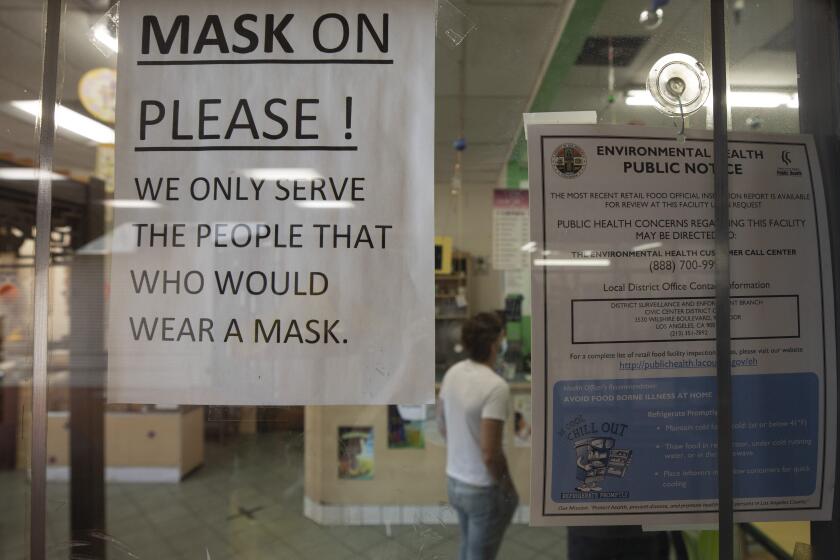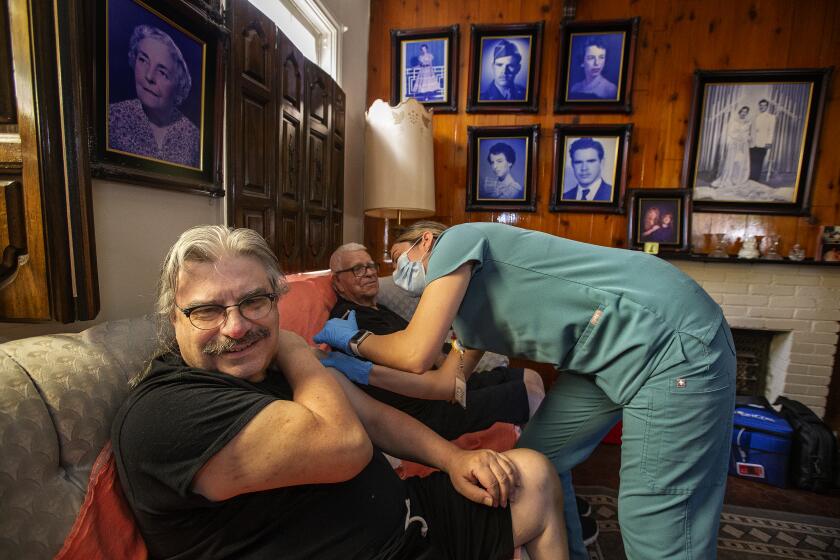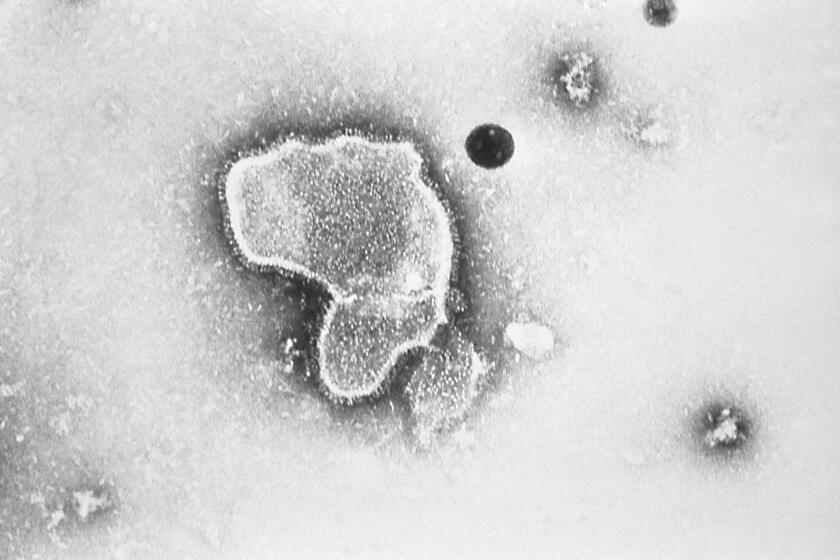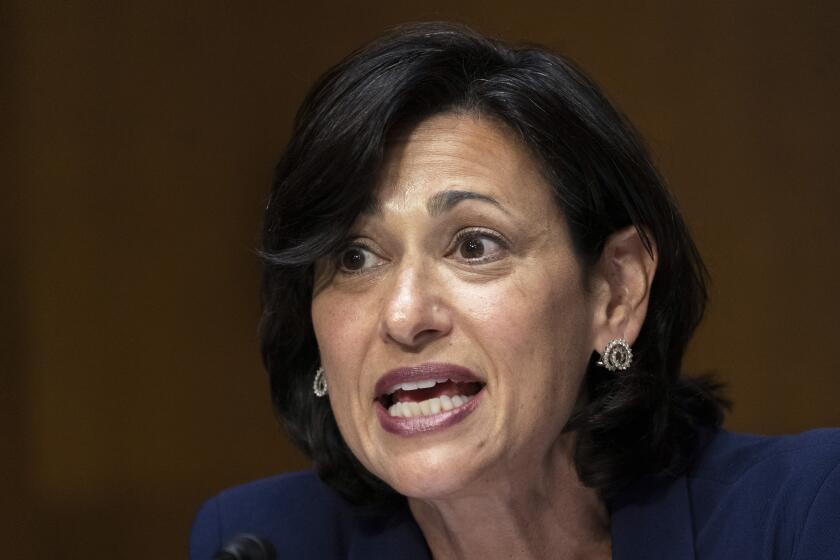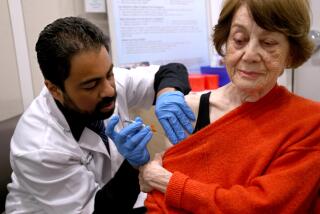‘Three threats at once’: California urges caution amid spread of RSV, COVID, flu
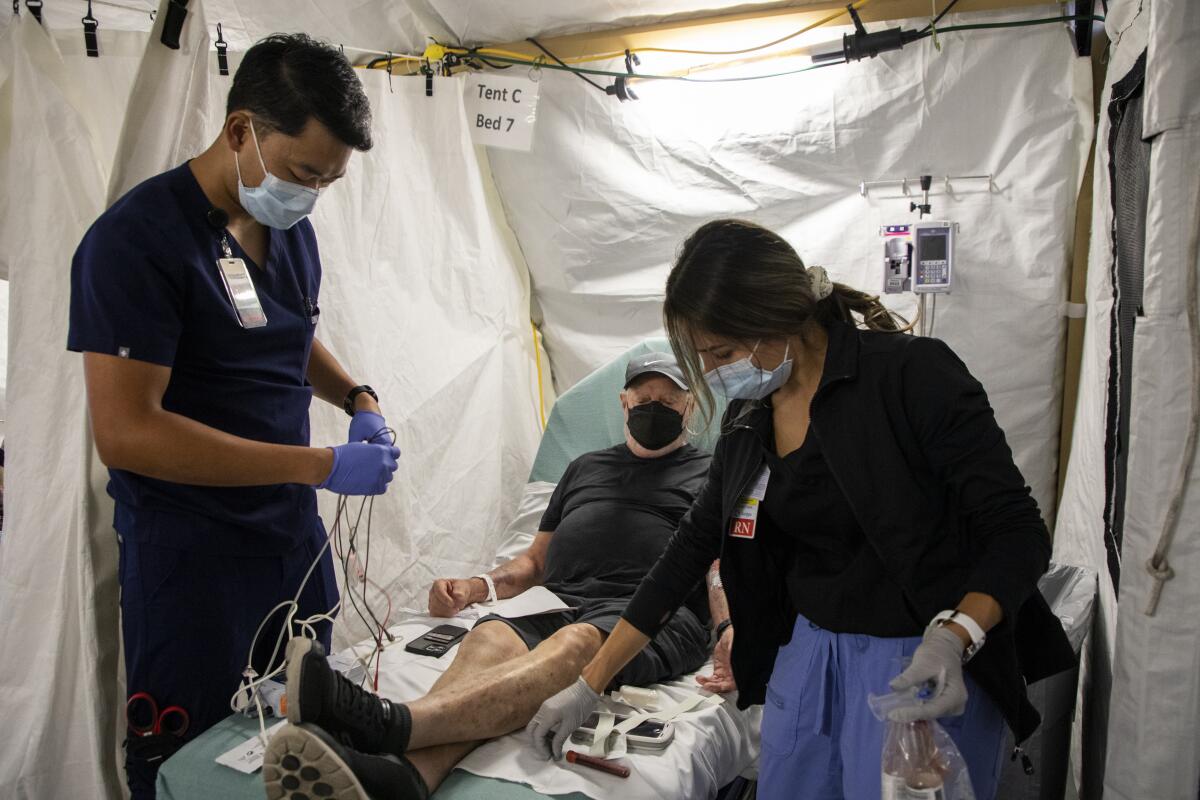
- Share via
California officials are urging preventive measures to thwart the spread of respiratory illnesses and alleviate a health system already contending with the triple threat of COVID-19, influenza and RSV.
For weeks, public health leaders across the most-populous state have sounded the alarm about the challenges posed by simultaneous circulation of the three viruses. With Thanksgiving and the rest of the holiday season around the corner, ways in which residents address these health challenges can help chart the state’s course through the next few months, officials say.
“We are dealing with three threats at once,” California Health and Human Services Secretary Dr. Mark Ghaly said this week. “In every category that we track — whether it’s test positivity, case rate numbers, wastewater surveillance, clinical surveillance, hospitalizations — we’re seeing increases for RSV, flu and COVID.”
Flu season’s positivity rate in Los Angeles County is at 25%, up from 13% a week ago, as RSV and COVID are still in circulation.
Of particular concern is RSV, respiratory syncytial virus, which can cause significant illness and death in young children and older people. It has struck with a vengeance, sickening so many children that some hospitals have reported running short of pediatric beds.
“We have seen an abrupt increase in all of our RSV cases,” said Dr. Vidya Mony, a pediatric infectious disease specialist at Santa Clara Valley Medical Center. “If you look at a lot of the curves, it’s almost linear ... so this is significantly more than we have seen in quite a few years.”
Compounding matters is the fact that pediatric hospital beds can be in short supply even in the best of times.
“Many hospitals have only a small number of pediatric beds, meaning that just a small number of new pediatric hospitalizations have the potential to put a hospital at capacity,” Los Angeles County Health Officer Dr. Muntu Davis said.
Orange County this month declared a health emergency amid a high level of RSV and other respiratory illnesses that required “hospitalization of children exceeding the capacity and infrastructure of our designated children’s hospitals,” officials said.
Masking has returned to being “strongly recommended” in indoor public spaces in Los Angeles County. Coronavirus cases are rising across California.
On Tuesday, L.A. County reported average daily occupancy of staffed pediatric hospital beds at 64%, up from 60% on Nov. 1. For pediatric ICU beds, average daily occupancy was 75%, up from 67%.
Both figures are higher than at any point in the last 17 months, according to Davis.
“These numbers do not translate to a dire situation at hospitals at this time,” he said, but the “increases in pediatric bed occupancy are concerning, especially given the fact that we are still early in the typical respiratory virus season.”
Whether that means the state is in for a virulent season, or just an atypically early one, is unknown.
“We have already experienced levels of test positivity for RSV infections among the youngest Californians that rival peaks from other years. And we’re not sure if they’re going to continue to go up or start to level off,” Ghaly said.
A confluence of respiratory illnesses has some California officials warning of a possible triple threat that could strain healthcare systems.
Adding to that uncertainty is the collision of COVID-19 and flu. The much-discussed “twindemic” failed to materialize in the last two years, as the state was wracked instead with horrific coronavirus waves. But that’s not the case this year.
“This is the first year where we’re not only facing COVID but also increased influenza activity and unusually high levels of RSV,” said Dr. Sarah Rudman, Santa Clara County’s deputy health officer.
While all three diseases may cause mild symptoms in older children and young adults, “they’re all especially dangerous for our youngest children, our oldest adult community members and people with other medical problems,” she told reporters Wednesday.
“Right now, we are already seeing these diseases hit our youngest children and impact our hospitals and our doctor’s offices to get care for these children,” Rudman said. “So with the holidays approaching, it’s especially important we do everything we can to prevent these diseases.”
Viral infections, specifically RSV, push pediatric hospitalizations to record levels in Orange County, prompting a health emergency.
Over the week ending Nov. 12, the most recent period for which data are available, flu activity was considered high in California, according to the U.S. Centers for Disease Control and Prevention. That assessment is based on monitoring for respiratory illnesses that include a fever plus a cough or sore throat, not just on laboratory-confirmed flu cases.
The early hot spot remains the state’s southeastern corner — San Diego, Orange, Riverside, San Bernardino and Imperial counties — but overall flu activity is increasing throughout California, state data show.
Pressures from respiratory illnesses have prompted some San Diego County hospitals to use overflow tents outside their emergency departments. Ghaly said Thursday he wouldn’t be surprised if other facilities are similarly strained or soon will be.
“It’s not surprising to me at all that some facilities — whether it’s because of flu or because of flu plus COVID plus RSV plus some other respiratory viruses that are circulating — are beginning to need to use alternative spaces, whether it’s tents outside or some areas indoors, to help create triage spaces, treatment spaces, to meet the need of their communities,” he said.
The last two flu seasons were relatively mild, a development officials credit in part to infection-prevention protocols intended to stymie COVID-19.
Children younger than 6 months have faced the second-highest rate of COVID-19 hospitalization across all age groups, trailing only those ages 65 and up.
But many of those — widespread masking, physical distancing and avoiding crowds — have gone by the wayside as pandemic conditions have improved.
In lieu of more stringent steps, health officials say, there are several ways residents can protect themselves and those around them. Wearing a mask in crowded or indoor public spaces, washing hands regularly, wiping down frequently touched surfaces, covering sneezes and coughs and holding events outdoors — or maximizing ventilation for those held indoors — can lessen the chance of transmission.
Officials also urge Californians to get vaccinated against both COVID-19 and flu. There is no vaccine available for RSV.
“I realize that many people are thinking that it’s too late to get vaccinated before Thanksgiving, because the vaccines need time to be effective,” Davis said. “While protection does ramp up over one to two weeks after you are vaccinated, this doesn’t mean that you will have zero protection until this point. You still have some protection, and you will be prepared for future events.”
Many experts say they expect COVID-19 to rebound this winter.
In L.A. County, the daily number of newly reported cases has jumped almost 70% from last month — though it remains well below previous waves.
“Cases are rising, new variants are emerging, and there is concern about hospitals reaching capacity,” Davis said. “I encourage everyone to use this information as a reminder that we need to take advantage of the resources that we have and use layered protections to have a safe holiday.”
Meanwhile, the coronavirus landscape continues to shift. The CDC estimates that BA.5 — the Omicron subvariant that has long been the dominant version circulating nationwide — has been surpassed by two of its descendants: BQ.1 and BQ.1.1.
While this could indicate that newer subvariants enjoy a growth advantage over BA.5, some health officials remain confident that the existing therapeutics and vaccines will blunt the worst of any winter wave. Included in that kit now are updated bivalent boosters that target both the original coronavirus strain and the dominant Omicron subvariants, including BA.5.
“It’s really up to all of us. We really have this golden opportunity to stay safe during this fall season as we prepare for the holidays,” said Dr. Rais Vohra, Fresno County’s interim health officer.
More to Read
Sign up for Essential California
The most important California stories and recommendations in your inbox every morning.
You may occasionally receive promotional content from the Los Angeles Times.

